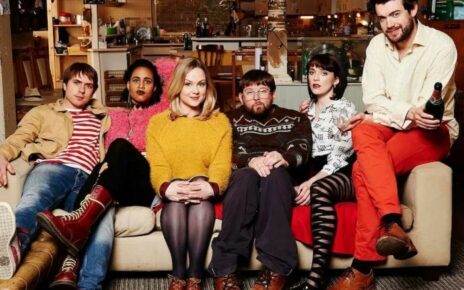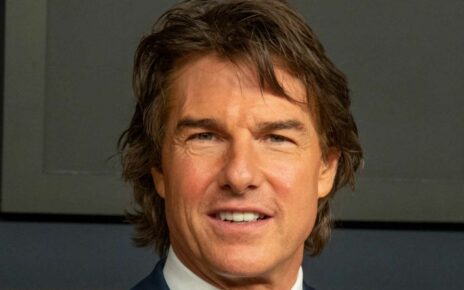The people behind “Mo” can say with a perfectly straight face that the new Netflix comedy starts off with guns blazing. Toward the end of the pilot episode, “Hamoodi,” Mo Najjar (Mo Amer) gets caught in a shooting in a grocery store — whether it’s a “mass” shooting ends up being a topic of debate for the EMTs on the scene. Either way, it’s just another damn thing that messes with Mo’s day, and is arguably less (spiritually) damaging than what happens right before, with Mo seeing samples for chocolate-covered hummus (yikes) and convincing the worker giving out the samples that his mom’s homemade olive oil is all you need.
The shooting itself is depicted through off-screen sound and hard cuts that focus the viewer’s eye on little moments of detail, conveying the shock of the situation. But it’s also a little hilarious, too: Those details include the ripped, bloodstained bag of cat food — with the most annoying mascot — that Mo’s brother Samir (Omar Elba) blackmailed him into getting, and bystanders who roast Mo’s counterfeit Yeezy’s (“Not the 500 Triple-Black?!”) as he’s carried toward an ambulance ride he can’t afford.
“Mo” isn’t the first comedy that has an earnest, dramatic heart to its story, nor the first that code-switches seamlessly between comedy and drama at the drop of a hat. But in building out Amer’s semi-autobiographical immigrant story, “Mo” director Slick Naim and editors Andrea Folprecht and Patrick Tuck were able to capture details so beautifully specific that they actually speak to the universal experience of trying to keep your head above water in life, work, and love.


“Mo”
Courtesy of Netflix
Naim honed in on the the touchstones of Palestinian culture, especially food, to give the show much of its texture. He also incorporated the landscape of Houston itself, which can wordlessly contextualize a situation Mo finds himself in or act as a tonal palate cleanser. The spirit of both where the character comes from and where he lives act as characters in their own right, Naim told IndieWire. “I felt like it needed to be handheld and feel like a struggle and feel like a hustle and really have that immigrant mentality both visually and sonically,” he said. “My whole pitch was to have these super wide landscape shots that can really embody Houston in certain landmarks and then juxtapose them with these tighter, kind of more visceral shots of when we feel like we’re really with Mo and feeling his struggle.”
For that struggle to be meaningful, Naim and cinematographer Timothy Burton made sure to make the things that give Mo life consciously beautiful onscreen, whether it’s the sun-soaked skyline of Houston or flowing, warmth-soaked detail shots Mo’s mother Yusra (Farah Bsieso) pressing olive oil by hand. “I think so much of [the style of the series] has to do with Timothy Burton’s cinematography and just how grounded he makes the show feel. It’s not like your typical run-of-the-mill handheld stuff all the time,” editor Patrick Tuck told IndieWire. “There’s real composition to his work and, and then Slick works really hard to make people feel grounded and real.”
It’s that sense of being grounded in the specificity of a place and of people, the ways that Mo’s family drives each other crazy but shows the depth of their love in what they do for each other, that editor Andrea Folprecht said helps the show switch from funny to suspenseful and back again — sometimes in the same scene — with ease. For the editing team, the visual details Naim and Burton provided could act as connective tissue in articulating unsaid bits of character psychology or just set a mood for the actors’ performance to resonate in the way they wanted. “Sometimes it happens that the editor has to sort of force a tone into something that’s not there,” Folprecht told IndieWire. “But Slick, Mo, all the actors, they knew [that with some lines], you just gotta say them. And then sometimes you gotta ad lib a sparkle in there, and our job is to catch the sparkles and make sure that they’re in the cut.”


“Mo”
Courtesy of Netflix
The visual richness of the series is very much grounded in music, an eclectic mix of everything from American hip-hop to Arab rap to Texas bluegrass that’s as multifaceted and lively as Mo (both the character and the creator) and the team that worked on the show. “I’ll just be creating playlists for them to help me visualize — it’s almost like a cheat sheet for me,” Naim said. “I can really see the scene vividly and I have to go execute that, and music is what helps me do that.”
“The music provides a lot of energy and I think the mixture of genres of music also provides that energy,” Folprecht said. “[Slick’s playlists would tip me towards] some of the rap, some of the Houston music, some of the Arabic music, and then working with [music supervisor Suhell Nafar, I would go to him and say], ‘Hey, I’ve got this scene where x happens,’ and he would send me options. The different styles of music give the show a uniqueness and an energy.”
The energy is constant, even if it’s expressed in very different ways. Sometimes a heartfelt ballad from an ’80s Arab TV show underpins Mo’s mother’s work to make food for her kids, sometimes Texas rap provides the flow for Mo selling sneakers out of his car, and both can exist comfortably in the same episode. Just as the series shows the breadth of Houston, it has a musical landscape the editors take advantage of to organize the story “As an editor, this is such a buzzword, but juxtaposition is key,” Tuck added. “What’s so cool about the show is, Mo is always in the wrong place at the wrong time. So to feel that, we’re constantly putting music that’s too fun in or lingering on shots that are making you think about what Mo’s actually feeling versus the facade that he’s putting on.”
“We had an embarrassment of riches. All of our first cuts were a lot longer because we could have let them riff for a lot longer. But we wanted to keep the show tight and energetic,” Folprecht added. “It’s about figuring out which are the best pieces to keep.”


“Mo”
Courtesy of Netflix
Juxtaposition is key in how the show can sometimes pare back its sonic and visual flare for moments of real emotional catharsis. The sequence in Episode 3 where Mo’s girlfriend, Maria (Teresa Ruiz), encourages him to unburden at Catholic confession is led off by cavernous establishing shots of the church and the creaking of Mo’s bare feet against the wooden floorboards, conveying his vulnerability in the space.
When Mo actually goes to talk to the priest (played by Bernard “Bun B” Freeman of Houston rap legends UGK), Naim and Burton’s camera choices make it impossible for Mo to wriggle away from his own discomfort, or the painful new information he’s learned about his father. “You have your challenges automatically when you’re in there because, first off, it’s been shot a million times. Second, it’s a box, right? It’s kinda like a telephone booth and there’s only certain ways you can shoot,” Naim said. “But in this instance, it worked to our advantage because [the claustrophobic nature of the space helped play up] Mo’s first time in there. There’s a Muslim in a church in a confessional. So it was important to feel that compression, you know, those upward angles pressing on him and him feeling that… and then ending up having an actual realization in there and changing the angle for that moment. We just had to switch things up and make it feel dope.”
If anything is a guiding stylistic principle for “Mo,” it’s the show’s ability to switch things up and make them feel dope in the series’ compositions and how they’re strung together in the edit. The show blends its comedic and dramatic impulses to give us a full sense of Mo as a character and his constant struggles, the big ones of trying to survive without having legal status and the sometimes even bigger ones of just trying to be present in his own life. “That’s life, too. You know?” Naim said. “One day’s funny, one day’s dramatic, the next day’s both of them together. It’s life.”
Source: Read Full Article

